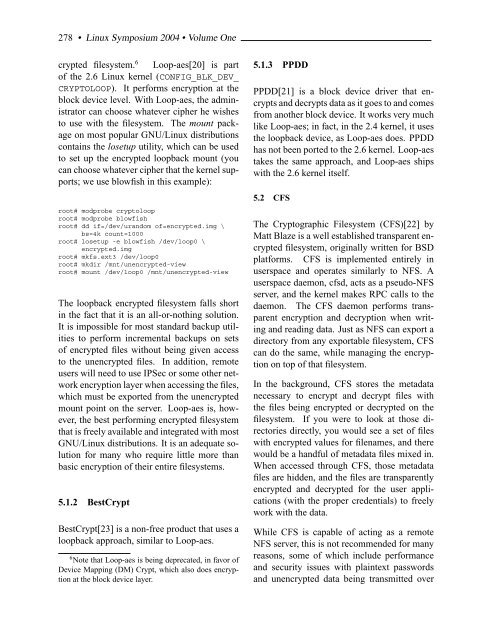Create successful ePaper yourself
Turn your PDF publications into a flip-book with our unique Google optimized e-Paper software.
278 • <strong>Linux</strong> Symposium 2004 • Volume <strong>One</strong><br />
crypted filesystem. 6 Loop-aes[20] is part<br />
of the 2.6 <strong>Linux</strong> kernel (CONFIG_BLK_DEV_<br />
CRYPTOLOOP). It performs encryption at the<br />
block device level. With Loop-aes, the administrator<br />
can choose whatever cipher he wishes<br />
to use with the filesystem. <strong>The</strong> mount package<br />
on most popular GNU/<strong>Linux</strong> distributions<br />
contains the losetup utility, which can be used<br />
to set up the encrypted loopback mount (you<br />
can choose whatever cipher that the kernel supports;<br />
we use blowfish in this example):<br />
root# modprobe cryptoloop<br />
root# modprobe blowfish<br />
root# dd if=/dev/urandom of=encrypted.img \<br />
bs=4k count=1000<br />
root# losetup -e blowfish /dev/loop0 \<br />
encrypted.img<br />
root# mkfs.ext3 /dev/loop0<br />
root# mkdir /mnt/unencrypted-view<br />
root# mount /dev/loop0 /mnt/unencrypted-view<br />
<strong>The</strong> loopback encrypted filesystem falls short<br />
in the fact that it is an all-or-nothing solution.<br />
It is impossible for most standard backup utilities<br />
to perform incremental backups on sets<br />
of encrypted files without being given access<br />
to the unencrypted files. In addition, remote<br />
users will need to use IPSec or some other network<br />
encryption layer when accessing the files,<br />
which must be exported from the unencrypted<br />
mount point on the server. Loop-aes is, however,<br />
the best performing encrypted filesystem<br />
that is freely available and integrated with most<br />
GNU/<strong>Linux</strong> distributions. It is an adequate solution<br />
for many who require little more than<br />
basic encryption of their entire filesystems.<br />
5.1.2 BestCrypt<br />
BestCrypt[23] is a non-free product that uses a<br />
loopback approach, similar to Loop-aes.<br />
6 Note that Loop-aes is being deprecated, in favor of<br />
Device Mapping (DM) Crypt, which also does encryption<br />
at the block device layer.<br />
5.1.3 PPDD<br />
PPDD[21] is a block device driver that encrypts<br />
and decrypts data as it goes to and comes<br />
from another block device. It works very much<br />
like Loop-aes; in fact, in the 2.4 kernel, it uses<br />
the loopback device, as Loop-aes does. PPDD<br />
has not been ported to the 2.6 kernel. Loop-aes<br />
takes the same approach, and Loop-aes ships<br />
with the 2.6 kernel itself.<br />
5.2 CFS<br />
<strong>The</strong> Cryptographic Filesystem (CFS)[22] by<br />
Matt Blaze is a well established transparent encrypted<br />
filesystem, originally written for BSD<br />
platforms. CFS is implemented entirely in<br />
userspace and operates similarly to NFS. A<br />
userspace daemon, cfsd, acts as a pseudo-NFS<br />
server, and the kernel makes RPC calls to the<br />
daemon. <strong>The</strong> CFS daemon performs transparent<br />
encryption and decryption when writing<br />
and reading data. Just as NFS can export a<br />
directory from any exportable filesystem, CFS<br />
can do the same, while managing the encryption<br />
on top of that filesystem.<br />
In the background, CFS stores the metadata<br />
necessary to encrypt and decrypt files with<br />
the files being encrypted or decrypted on the<br />
filesystem. If you were to look at those directories<br />
directly, you would see a set of files<br />
with encrypted values for filenames, and there<br />
would be a handful of metadata files mixed in.<br />
When accessed through CFS, those metadata<br />
files are hidden, and the files are transparently<br />
encrypted and decrypted for the user applications<br />
(with the proper credentials) to freely<br />
work with the data.<br />
While CFS is capable of acting as a remote<br />
NFS server, this is not recommended for many<br />
reasons, some of which include performance<br />
and security issues with plaintext passwords<br />
and unencrypted data being transmitted over

















